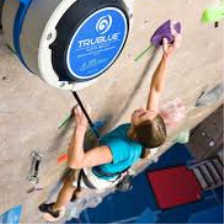Autobelay (Automatic friction application) Systems and Climbing Incidents
Autobelay systems are widely used around the world in climbing gyms. Probably the most popular system has about 16,000 units worldwide, of which there are about 4,000 here in the UK.
Autobelays work by retracting into the unit as a climber connected to the autobelay tape climbs their selected route. The tape reels in and once the climber has reached the top or falls off, the tape lowers at a controlled speed back to the floor. It sounds the perfect safe system doesn’t it? No second climber trying to hold a safety rope and stop their climbing partner falling to the ground.
So we ask why has there been a steady report of climbers falling to the ground and being injured or even tragically killed?
In recent years there has been increasing evidence of incidents and climber injuries and even fatalities where autobelays were being used incorrectly. Fixed barriers at the bottom of climbs are often in place to stop people climbing the route until the climber is connected to the autobelay – surely this stop people? Not totally. Climbers often start climbing to one side of the barrier to ‘check out’ their route, and often simply forget they are not clipped in to the system, until they are at or near to the top and suddenly realise they are not clipped in.
IEW experts during their investigations into these incidents have in nearly every case shown that it is human error that is the cause of the incident because the safety devices are standardised and are functional. Common mis-use includes: The climber clipped into the wrong part of their harness; the climber didn’t clip into the system at all; the climber climbed round or over the barrier to check out the route and so on.
One identifiable aspect of many incidents is that the climber involved in such incidents is often a middle aged male and who has been climbing for over 10, 15 or even 20 years, and has apparently switched off that safety switch in their brains, simply because they are not talking to their climbing partner who would ordinarily be there and ready to hold their climbing rope. This can be put down to “
Heuristic Traps” of which there are many that we as humans can fall into; five traps that are generally applicable to a climbing/ mountainous situation:
- Familiarity
- Commitment
- Scarcity
- Social proof
- Expert/instructor halo
Another aspect is that often climbers have called in to their climbing gym on lunch hour and aim to climb three or four autobelay protected routes before going back to the desk. And as they are alone with no friends to check on them, they are totally reliant on their own safety awareness to ensure they are connected, or not as often happens when lunch time climbers don’t get off the floor to return to their desk.
In exceptional cases, children under supervision have been incorrectly clipped in or not clipped in at all, only to fall and take a ground impact with associated injuries. In these incidents, it is often the case that the staff involved were either poorly trained or did not supervise the activity correctly. Often poor risk assessment and/or a failure to follow control measures contained in the operational procedures was found to be a significant aspect of these incidents.
Another notable factor is that when you read the above observations and comments, it is never the autobelay unit that is faulty. One system is designed so that even if the main lowering system jams or fails, the mechanical parts in the unit will still lower the climber to the ground, but will not retract back up, i.e. the tape stays in a loose pile on the ground. It is believed that there has not been a single case of a unit failure resulting in incident or injury.
So how might incidents be reduced, climbers not injured and climbing gyms not facing constant litigation?
There are some simple measures that can reduce the incident rate:
- Put BIG barriers across the bottom of the climb and connect the tape to it. By big make it a sheet of 8 feet by 4 feet with a stiff long edge where the autobelay carabiner is clipped into.
- Use a two-part system for connecting the climber to the autobelay unit – the unit does not release from the barrier until the climber is connected to the climbing tape.
- Signage may assist in reminding climbers – “Are you clipped In?” in big letters on the floor might raise climbers attention to checking themselves.
- Climbing gyms should review their staffing systems and consider having floor walking staff routinely observing the autobelay areas, especially when they see climbers leaving the floor.
- Getting every climber to carry out a practice descent from 2m means they might look at the connection point before letting go (the autobelay will still lower them at this low height).
- If climbing alone, getting climbers to look around and see if other climbers confirm they are clipped in – Nudge their behaviour towards a safer day out!
- With children, walls should have adequate, well trained staff with good risk assessment and control measures, and who receive ongoing training and re-validation, and have effective emergency systems in place to deal with a possible climber who is not connected to the autobelay.


